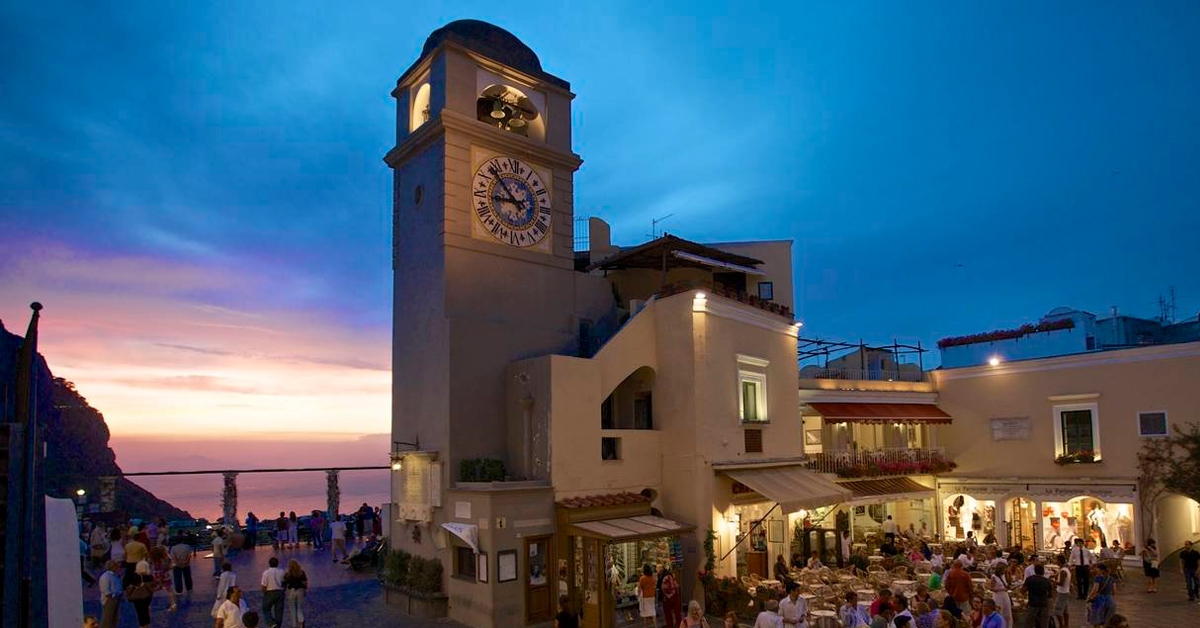Cart
Total: € 980.00

The people of Capri call it the square, or rather '' a
chiazz ", to put it in dialect. On maps it is marked as Piazza Umberto I.
For the rest of the world it is La Piazzetta. For everyone it is the center of
the island. For anyone who arrives in Capri it is impossible not to pass by
doing slalom among the bar tables.
Of course, it does not have the sinuous shape of a heart, it
is square like a chessboard, but when you go through it you cannot help but
fall in love with it.
You immediately understand why it is nicknamed the
"Living room of the world": everyone, poor and rich, stop in the
Piazzetta under the colored umbrellas of the bars and immediately feel at home.
In place of the fireplace to warm up there is the sun. You don't need
television because a few steps away you have the sea and the comedy of life
that slips under your eyes. Then there are those who take care of you,
delighting your palate and honoring the sacred cult of Capri hospitality.
The Piazzetta, which locals call in dialect
"chiazza", hosted artists, writers, heads of state and even criminals
of the caliber of Lucky Luciano. Yes, really him. The Sicilian gangster was
forbidden to return to the United States after helping the US government
disembark in Sicily.
But not only! The square has launched fashions with the
innate elegance of Jaquline Kennedy, an icon of the Capri style. The first lady
loved to rest in the chiazza to drink coffee with cream or an aperitif.
The square Umberto I has attracted the attention of media
all over the world also for his eccentric characters: during the sweet life the
aristocrat Alessandro Maria Galeazzo Ruspoli used to show up with a parrot
perched on his shoulder.
Sit down in the square and listen
to it as it tells its story, its anecdotes, its beauty.
The square of Capri has always played a fundamental role
in the history of the city.
In Greek times the Piazzetta of Capri was perched within
defensive walls. These stone blocks started from the San Michele hill to
Tiberius, they skirted today's Via Castello up to the top of Castiglione. Today
what remains of the city wall is visible only from the terrace of the square, via
Longano and via Castiglione.
Instead, in Roman times the fortifications around Piazza
Umberto I were partly demolished to make room for urban development. The island
no longer needed to protect itself from potential invaders, with the domination
of the emperor Augustus and Tiberius a long period of peace lay ahead.
In the Middle Ages the Piazzetta was once again secured. The
pirate raids, which terrorized the population, made it necessary to build
fortified gates. Meanwhile, the face of the most famous square in the world
began to change with the construction of the residence of Count Giacomo
Arcucci, advisor to the Neapolitan queen Giovanna I d'Angiò.
The nobleman's palace dominated for its size compared to the
rest of the houses that did not exceed the two floors. For this reason the
entire Arcucci complex was known by the name "Big Houses".
Currently the building houses the Ignazio Cerio Museum which
shows the paleontological and naturalistic remains collected in Capri by
Ignazio Cerio.
Between the 16th and the 17th centuries the raising of the
bishop's palace began, nowadays the Town Hall. Piazza Umberto I definitely took
its quadrangular shape. Meanwhile, the widening was used to practice defensive
operations against the Saracens.
In 1656 the island of Capri was overwhelmed by the plague
and the Piazzetta became the place to exorcise the fear of the epidemic: the
clothes of the infected were burned right in the small square in the center of
the country. Not far away, near the city gate, was also built a votive chapel
in San Sebastiano, protector of the plague victims.
In the eighteenth century the Piazzetta left behind weapons
and diseases to make room for the market
of vegetables and fish, rarely of meat, a once very rare
commodity. In 1938, the young Caprese Raffaele Vuotto arranged some small
tables and the Piazzetta took on a more mundane character. From that moment it
became a reference point for the social life that took place in hotels and
private homes before. Now for many it is the living room of the world and on
summer evenings there are Hollywood actors together with common people.
The whole history, beauty and liveliness of Piazza Umberto I
are immortalized in our Capricharme silk scarves. The precious material, light
and able to reflect the light in an inimitable way, makes the representation
lively and vibrant, so much that you will feel like sitting at one of the Capri
cafes, surrounded by the splendid multicolored flora that frames the alleys of
the city.
All the typical caprese nuances are present in the articles
we offer: violet of campanulas and vines, yellow of lemons and brooms, the
green of olives and the rich vegetation that covers the island's hills.
A product so durable and soft that you will forget to wear.
You can wear it around your neck or even use it as an additional accessory to
your Capricharme bag.
Our silk scarves are cool in summer and warm in winter, so
it's not a garment to be bought only in hot weather, but it's also a great gift
idea to propose under the Christmas tree.
You will only have to buy it. Gift wrapping is already
included!
© 2019 Capricharme All Rights Reserved
